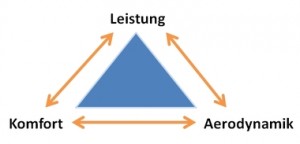Pillars of bikefitting
Almost everyone who regularly sits on his bike thought about whether the own position on the bike is convenient: The one because physical problems start troubling him after a short time on the bike, the other because in an altered position he may get even more power onto the pedals.
What does “fitting position” actually mean?
The quest for the optimal seating position (a.k.a. “bikefitting”) always is a balancing act. The three main pillars comfort, performance and aerodynamics need to be put in an optimal relation. In doing so, the pillars partly complement each other (performance and aerodynamics), partly they are in tension (comfort and aerodynamics). Let us first roughly define the pillars:
Comfort = Well-being of the human on the bike
Performance = Conversion of the human’s muscular strength in propulsion
Aerodynamics = Wind-permeability of the human + bike system
The tension between comfort and aerodynamics is the most obvious: A position that maximizes wind-permeability is stretched, bent low above the handlebar and narrow. This position offers only little comfort and thus cannot painlessly be ridden over an extended period of time. Accordingly, a compromise needs to be found to release this tension and this compromise differs for each individual athlete. How much comfort is needed depends on the individual history:
– What discomfort is already present?
– Since when is the individual cycling?
– Which other sports were performed earlier or are performed additionally?
Besides the history also the individual goals play a decisive role in the bikefitting process:
– What is the overall goal in cycling? A healthier way of living or winning races?
– What distance do the envisaged goals have?
– How extensive is the envisaged training?
Bikefitting recurrently is about compromising; an example: “I would like to sit aerodynamically, but it should still be comfortable after 3-4 hours!” A solution is hard – but not impossible – to find: a position is chosen where the aerodynamics is slightly improved while the loss in comfort remains small. A position that is too aerodynamic is often not advisable due to muscular predispositions, such as a lacking flexibility in the back thigh.
Summary:
The balance of comfort, performance and aerodynamics is a guiding principle of our bikefitting. The “ideal” relation needs to be found for each athlete individually. To do so, both the history and the goals should be taken into account in the dynamic analysis.
Author: Daniel Schade



